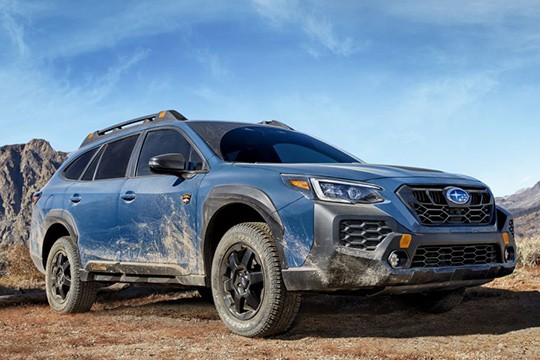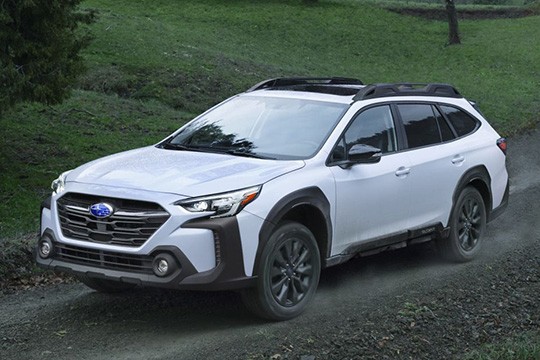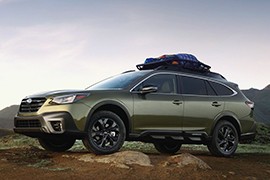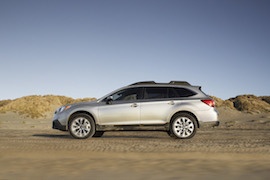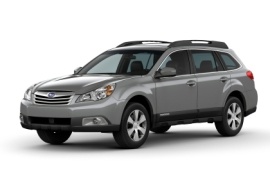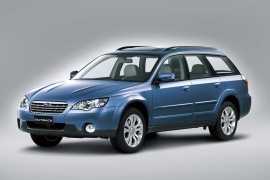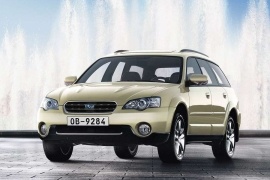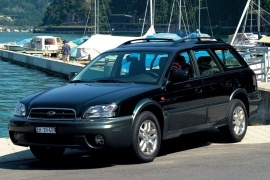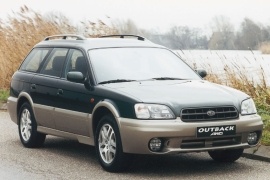SUBARU Outback Models/Series Timeline, Specifications & Photos
First production year: 1998
Engines: Gasoline, Diesel
Body style: Wagon (station wagon, estate, combi, touring)
Subaru refreshed the sixth generation of the Outback lineup in the spring of 2022, and along with the rest of the range, it also updated the Wilderness version of its crossover.
Subaru tried to do something different with the Wilderness version than just a trim level. While the car was based on the same refreshed 2024 Outback, it had many different features and exclusive details that made some customers wonder if these two vehicles were closely related. Moreover, regardless of its trim level, the regular Outback couldn’t chase its Wilderness sibling everywhere.
With its specific front bumper, the Wilderness version was clearly aimed at customers different from those looking for a daily-driving sporty station wagon on stilts. At the front, Subaru added bright orange trims in the bumper’s mid-section. At the same time, the lower side featured multi-LED fog lamps that flanked a lower air intake adorned by a hexagonal pattern mesh. Furthermore, the entire lower side was black and unpainted to better withstand scratches from stones and roots.
While the Outback looked like a station wagon on stilts, the Wilderness version looked more like an Outback with army boots. The extended plastic cladding around wheel arches and side sills emphasized its 9.5-inch (24 cm) ground clearance, up from 8.7-inch (22 cm) of its sibling. Since Subaru made this version for those craving sleeping in the woods, it added a reinforced roof rack that could withstand a 700-lbs (318 kg) static load, built to support roof-camping gear. At the back, the Outback Wilderness featured a black bumper adorned by two bright orange trims that echoed those from the front of the car.
Inside, Subaru added a specific upholstery to the car, adorned by bright orange tags on the door cards. Furthermore, the automaker added copper-gold trims on the lower spoke of the steering wheel and the gear selector housed by the center console. The front high bolstered bucket seats were upholstered with StarTex water-repellant upholstery and provided excellent side support. Fronting the driver was a mixed instrument panel that featured large dials for the analog speedometer and tachometer that flanked a TFT screen that showed data from the car’s onboard computer. In the back, the automaker added standard vents for the rear-seated passengers.
Subaru offered the Outback Wilderness with one engine option, a 2.5-liter turbocharged flat-four powerplant, which sent its power in all corners via the same Lineartronic (CVT) gearbox. The 18” alloy wheels wrapped in AT tire were specific for this car version. The revised suspension and transmission programs could help the vehicle reach remote areas deep into the forest. It wasn’t afraid to have its wheels or bodywork dirty. Last but not least, the metallic shields under the bodywork offered improved protection for the car against stones, branches, or roots.
Subaru has upgraded the sixth generation of the Outback and unveiled it at the 2022 New York Auto Show, and the new model has been improved on the exterior, interior, and under the hood.
The Japanese automaker decided that it didn’t have to rush and launch a seventh generation of the Outback just four or five years after the model’s introduction. Still, it did consider refreshing it, and even though there were no major changes at first sight, customers could notice them. Subaru added the Onyx Edition trim level, which was available with two engine options.
One of the most visible changes for the Outback 2023 model year was at the front, where Subaru installed a new bumper. The lower side of it, on the apron, featured a revised area that included round fog lamps edging the grille and thin and tall air intakes on the sides for air curtains that improved aerodynamics. In addition, all grades came fitted as standard with LED headlights. These changes didn’t affect the Wilderness trim level, though.
From its profile, the 2023 Outback boasted standard 17-inch alloy wheels for the base level, while the other got a set of 18-inch ones. The automaker also redesigned the black plastic cladding around the wheel arches, which were penned with a more aggressive look. The upper grades also got turn signals in the door mirrors. At the back, the raked forward tailgate adorned by a roof spoiler was available with hands-free closing, depending on the grade. The keyless entry and start were kept.
Inside, the car greeted its customers with StarTex water-repellant-covered, high-bolstered seats. Upper grades were available with leather upholstery, heating and ventilation, and were power-adjustable. On the center stack, the base version featured a dual touchscreen system for the infotainment system. All the other grades have received an 11.6-inch touchscreen featuring Subaru Starlink. Unfortunately, the rearview camera’s resolution was still poor. Still, the updated infotainment unit’s software improved the system’s response to inputs. Fortunately, Subaru didn’t fall into the same trap as other automakers to remove the physical turning knobs for the volume or tune.
Moreover, the EyeSight safety system was enhanced with smaller-sized cameras mounted left and right of the rearview mirror than on the non-facelifted version. In addition, Subaru offered an LCD screen instead of the said mirror that was connected to a rear backup camera.
Under the hood, the facelifted version of the Outback’s sixth generation came with the same 2.5-liter flat-four engine as in the 2020 model year, with or without a turbocharger. The base version sent 182 hp (185 PS) in all corners via a continuously variable transmission (CVT), known as Lineartronic in Subaru’s language. Those who wanted more could get the XT version with its turbocharged engine that sent 260 hp (264 PS) via the same transmission.
The sixth generation of the Outback broke cover in 2019 at the New York Auto Show, boasting the same impressive go-anywhere attitude as its predecessors.
What started as a jacked-up station wagon in 1994 ended up as a full-legit different model in Subaru’s stable. But the automaker didn’t go over the edge to create a designated platform for this crossover. It used the same one from the Legacy, as it did on the previous five generations of the Outback. It was also loaded with safety features that made the vehicle highly attractive. Yet, in terms of styling, it wasn’t a big step up over its predecessor, and it still looked like a station wagon on stilts, not a proper crossover vehicle. On the other hand, Subaru wasn’t reckoned for its fantastic design studio but for its all-wheel drive systems, and all versions of the Outback featured it.
Subaru introduced the sixth generation of the Outback just five years after launching the fifth generation of this moniker. Its front fascia featured swept-back headlights with integrated C-shaped daytime running lights. Depending on the trim level and options, it sported a chromed or black grille with horizontal slats as part of the upper bumper area. The lower side of the bumper was left black to create a rugged look for the car. Last but not least, the automaker installed LED fog lamps that flanked the lower air intake.
From its profile, the wagon-like look of the Outback was enhanced by the black wheel well-claddings and side skirts of the same color. The car had an almost identical wheelbase to its predecessor, so it offered similarly-sized doors. Thanks to its jacked-up suspension, the crossover boasted an 8.7-inch (22 cm) ground clearance and could handle more than just small potholes on the road. The chromed trim that surrounded the window area made the car look more upscale, while the raked forward tailgate adorned by a roof spoiler made it look sporty. Finally, all versions came fitted with roof rails for additional storage area.
Inside, the sixth generation of the Outback greeted its customers with high-bolstered front seats and an up to 11.6-inch center touchscreen for the infotainment system. Fronting the driver was an instrument cluster that featured two large dials for the speedometer and tachometer, flanking a TFT display for additional information from the car’s onboard computer. In the back, the 60/40 split-folding bench seat could accommodate three adults, and the adjustable tilt for the backrest was also an appreciated feature. The 32.5 cu-ft (920 liters) trunk space could expand to 75.7 cu-ft (2,144 liters) with the rear seats completely folded. For customers’ peace of mind, Subaru installed the EyeSight Driver Assist technology that included lane-keeping assist with automatic steering adjustments, emergency braking, and automatic cruise control.
Under the hood of the Outback’s sixth generation, Subaru installed a 2.5-liter flat-four engine with or without turbocharging. Both versions were paired with a CVT transmission, known as the Lineartronic, that ensured smooth driving.
The Subaru Outback was designed for active people who love to go hiking. It was the up-lifted station-wagon version for the Legacy sedan. The 2015 model showed a big improvement in almost all areas.
The 2015 Outback didn't want to look like a rugged off-road vehicle. It was a crossover and it wasn't ashamed to tell that from the first look. It did have some off-road inspired details such as the black plastic details on the fenders or the bulky side-sills, but it was just a crossover built on a sedan chassis.
The exterior look was changed, with a raked windshield and roof-rails on top. A clever system allowed the driver to hide the transverse bars inside the long rails to decrease the wind noise when they were not used. A better aerodynamic helped the car to be quieter on the road and made the journeys more pleasant.
Inside, there was a new infotainment unit with a touch-screen for navigation and audio controls. There was room for five, but with limited leg-room for the rear-seat middle passenger due to the transmission tunnel.
As usual, the Outback featured the symmetrical AWD system. It was offered with two engine choices. The base model, with a flat-four 2.5-liter engine, was mated as standard with a 6-speed manual. The top of the range 3.6-liter was the same as before and mated exclusively with the CVT transmission. A manual mode with 6 preset gears was installed, with paddle shifters behind the steering wheel.
Subaru introduced the fourth generation of the Outback in 2009 in April at the New York International Auto Show and built it on the Legacy's fifth-generation platform.
Those were the dark days of the world financial crisis, and most automakers shrunk down their operations. Subaru, on the other hand, chose to invest and launch new products, such as the Outback, also known as the BR or BM. But the cost-cutting measures were seen in this model since it lacked some of the features that made this brand famous around the world, such as the frameless windows.
The car's bodywork was basically a raised version of the Legacy station wagon but with several improvements. Thus, the ground clearance was raised to a respectable 8.7" (22 cm), and the front bumper got a lower unpainted plastic part that housed a splitter and the fog lamps. From its profile, the long-roof vehicle kept the same body panels as its non-raised sibling. Subaru chose not to install trims around the wheel arches to emphasize the car's off-road characteristics. That, along with the dismissal of the double-sized sunroof, was part of the cost-cutting measures.
Inside, the crossover was large enough to accommodate five adult-sized passengers for short jaunts. Still, for long travels, the person seated in the middle position on the rear bench lacked the appropriate space for their feet due to the transmission tunnel. It wasn't very bad, but not comfortable either. Behind the 60/40 split-folding bench, the Outback provided a generous trunk fitted with a very low loading lip.
Under the hood, the Outback received flat-four or flat-six engines ranging between 150 PS (148 hp) and 260 PS (260 hp). On specific markets, Subaru offered turbocharged gasoline engines or turbo-diesel powerplants.
For the 2005 model year, Subaru operated some mild changes to the third generation of the Outback, and the most essential one was the addition of a new engine version.
The Japanese automaker introduced the third generation of the Outback in the European market in late 2003 at the Frankfurt Motor Show, but the American customers had to wait a little more to get it. Then, Subaru unveiled it at the 2004 Chicago Auto Show for the 2005 model year. This time, it came fully equipped with everything its drivers wanted and then some more. Besides the car’s look, the 2005 Outback was also fitted with a punchy turbocharged engine and a smooth-running flat-six powerplant, which delighted its customers.
At the front, their organic-shaped headlights but with sharp edges resembled eagles’ eyes. Since the Outback was a crossover, it had a different bumper than its street-oriented sibling, the Legacy, on which it was based. As a result, it had integrated round fog lamps on the outer sides of the apron that flanked a broad and flat air intake in the lower part of the bumper. Last but not least, the functional hood scoop warned other drivers that this crossover could perform very well on pavement.
From its profile, the plastic claddings that decorated the doors were not there just for the look. They protected the bodywork against bush scratches while going on unpaved roads and were effective against shopping carts as well. One of Subaru’s main distinctive design components was the frameless door windows, which made the car look sportier. Furthermore, the thin and blacked-out B-, C-, and D-posts made the Outback look sporty for a station wagon. That impression was emphasized by the raked-forward tailgate at the back, which was adorned by a small roof spoiler at the upper side of the rear window.
Inside, Subaru used higher quality materials on the Outback’s third generation. Base models used fabric upholstery and just a few attractive amenities such as AC, a stereo, and power windows on all four. The XT, which stood at the top of the car’s trim levels, featured power-operated leather seats, an in-dash six-CD changer, and a double-panel moonroof. While the front passengers enjoyed their bolstered seats, there was not enough room for three adult-sized passengers in the back for long travels. Still, the 60/40 split-folding bench seat could easily accommodate three kids to and from their schools. In the trunk, the Outback offered 33.5 cu-ft (948 liters) of space, while with the seats folded, it maxed out at 66.2 cu-ft (1,874 liters).
Under the hood, the automaker installed a choice of three engines, depending on the market. There were two 2.5-liter flat-four powerplants, with or without turbocharging. The top-of-the-line version was powered by a three-liter flat-six, naturally-aspirated engine. There was also a choice of three gearboxes: a four-speed automatic, a five-speed automatic, or a five-speed manual. Power went in all corners, and that was a standard feature.
Subaru rushed the Outback’s third generation on the market and launched it in 2003 at the Frankfurt Motor Show in Germany, and the changes over its predecessor were massive.
While customers started to be more attracted by crossovers, most automakers were not ready to provide one. Subaru, on the other hand, thanks to its vast experience in producing all-wheel drive vehicles, had the edge on that. As a result, after introducing the Outback nameplate in 1994, the Japanese automaker quickly came with a second generation of it in 1998, followed by the 2003 model. If the previous models were more or less shy tryouts, the third generation was bold and came fully loaded with more than what regular customers asked from a crossover.
The third generation of the Outback was based on the fourth generation of the Subaru Legacy, which was introduced in May 2003. As a result, its front fascia looked very similar to its sibling. The organic-shaped headlights that resembled a pair of eagle eyes flanked the wide hexagonal grille that sported the Subaru badge in the middle. These elements were common for both vehicles, but the bumper was new. It featured large and round fog lamps in the lower part, flanking the lower air intake for the vehicle.
From its profile, the Outback boasted a higher ground clearance than its sibling. In addition, it featured additional cladding on the door panels and side sills to resist scratches and shopping carts better. All versions of the Outback came fitted with roof rails, but only the top grade featured a panoramic glass roof. One of the car’s unique assets was the frameless doors, a Subaru design signature seen on the Impreza lineup as well. At the back, the raked-forward tailgate was adorned by a roof spoiler on its top. Lower, the bumper also featured a black, unpainted, scratch-resistant area.
Inside, customers found a larger cabin than on the Outback’s second generation, fitted with higher-quality materials. The minimalist design of the dashboard delighted customers. At the same time, the automaker placed the instrument cluster in front of the driver, featuring a clean layout, with the speedometer and tachometer in the middle, flanked by the fuel level and coolant temperature gauges. At the front, Subaru installed a pair of bucket seats, while out back, a split-folding bench could accommodate up to three adults on it.
Under the hood, Subaru installed a choice of two engines: a 2.5-liter flat-four and a 3.0-liter flat-six. The former was available with either a five-speed manual or a four-speed automatic, while the latter was paired with a five-speed manual only, with an auto-shift function. Compared to the previous generation, the 2003 Outback came with a slightly longer wheelbase, a lighter construction, and an improved suspension.
It was the last manufacturing year for the Outback’s second generation, but the automaker didn’t want to let it go without a final update and refresh to keep the nameplate alive in its customers’ memory until the third generation of this moniker was available.
Subaru introduced the second generation of the Outback in Japan in late 1998 and started production in the U.S. in 1999 for the 2000 model year when the first customers got their vehicles. Even if the car was not considered highly attractive in terms of styling, it still had its advantages in the tech department that made buyers crave one. Then, in 2002, Subaru added a few updates to the Outback and also introduced the H6-3.0 L.L. Bean edition, which had all the bells and whistles someone could put on a Subaru. For the European market, the Japanese automaker kept the car virtually unchanged.
At the front, the Outback featured rectangular headlights with rounded corners, horizontally divided, where the upper area was for the high and low beams while the lower was for parking lights. The U.S. versions featured amber corner-mounted blinkers, while its European sibling had clear lenses with orange bulbs. On the lower bumper, the L.L. Beam got a golden paint, which contrasted with the green color of the vehicle. In Europe, on the other hand, the cladding and the bodywork sported the same paint.
From its profile, the car’s 16-inch light-alloy wheels had a new design for the L.L. Bean and the upper trim levels. At the same time, lower grades retained the same five dual-spoke alloys wrapped in 215/60 tires. One of the reasons why the Outback was so popular was credited to its tailgate, which opened from a very low area, cutting a portion of the car’s rear bumper. Following the “give them all” recipe, the L.L. Bean had a standard dual panoramic moonroof, where the front one tilted upwards and the rear one could be retracted.
Inside, the main attraction was the newly introduced McIntosh stereo that featured an in-dash 6-CD changer. The automatic air-conditioning was also standard, and customers could enjoy the comfortable, leather-wrapped seas. Fronting the driver was the standard Outback instrument cluster filled with two large dials for the speedometer and tachometer, the gauges for the fuel level and coolant temperature, and a small LCD mounted on the lower side that showed the odometer. In the back, there was plenty of room for three passengers, although taller occupants could criticize the lower roof due to the dual-panel moonroof.
Under the hood, the 2002 Outback could be fit with either a 2.5-liter flat-four or a 3.0-liter flat-six gasoline engine. The McPherson front struts and the multi-link rear system offered an excellent compromise between performance and low running costs. The four-cylinder powerplant could be ordered with either a five-speed manual or a four-speed automatic.
Just four years after it introduced the Outback nameplate in its inventory, Subaru launched the second generation of this moniker in 1998 in Japan, with sales starting in 1999 and 2000 for other markets.
The second generation of the Outback came just a few months after the launch of the Legacy’s third generation. Subaru already knew that customers were no longer satisfied with regular station wagons and tried to offer them something more. Thanks to the higher ground clearance and the all-wheel drive system, the Outback was alone on a market filled with people looking for a vehicle able to do more than just carry five adults and plenty of luggage in the back on asphalt. That was way too easy, and everybody could do it. Subaru, on the other hand, thanks to its vast experience in producing all-wheel drive systems, could provide something more, and that was the Outback.
Thanks to the higher ground clearance than the Legacy Wagon, on which platform the Outback was based, Subaru could install a beefier front bumper fitted with large round fog lamps on the lower side. These flanked a lower air intake that helped to cool the engine. In addition, thanks to the contrasting color of the bodywork, the crossover could stand apart from its competitors.
From the outside, the plastic claddings on the bodywork matched the front and rear bumpers’ color, offering additional protection against minor scratches, such as those caused by bushes and shopping carts. But Subaru was also known for its frameless doors, which it kept for the Outback’s second generation. In addition, the black B- and C-pillars added a sporty image to the vehicle. Last but not least, the Outback also featured black D-pillars, which created a wrap-around glass-looking area for the rearmost part of the crossover.
Inside, the automaker improved the quality of the materials over the previous generation. It also expanded the options list and added a dual-panel glass moonroof. The lower trim levels featured fabric upholstery, while the best-equipped one offered a leather-wrapped cabin. The driver fronted a simple analog instrument cluster fitted with large dials for the tachometer and speedometer and smaller gauges for the fuel level and coolant temperature. On the center stack, a new sound system was added, while the center console housed the gear selector or the gear stick, depending on the option, and a small storage area. Behind the split-folding (60/40) bench seat, customers could load up to 34.3 cu-ft (971 liters) of luggage with all seats in place and 68.6 cubic feet (1,943 liters) with the rear seats folded.
Under the hood, Subaru installed a 2.5-liter flat-four gasoline engine. Later, it added a 3.0-liter flat-six that made the car move quicker. The former version was available with either a five-speed manual or a four-speed automatic with a gated pattern for the shifter. The latter was a four-speed automatic affair only. Power went in all corners via Subaru’s proprietary all-wheel drive system.
